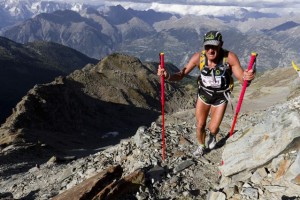First, let’s think about what they me an by shorter races. For this research, which examined the wear and tear on people competing in the Tor des Géants, a 330 kilometer trek through the Italian Alps, the shorter races include such dashes as the 166-km Ultra-Trail du Mont-Blanc and the 161-kilometer Western States Endurance Run. No, this is not a joke, and according to Science magazine, the researchers found that, compared with racers in similar events of one-half to one-quarter of the distance, competitors in the Tor showed less muscle fatigue and much lower levels of inflammation in their blood. Science reports that in tests of fatigue in muscles at the knee and foot, racers in the Tor showed only half the decrease in strength observed in runners in the 166-km Ultra-Trail du Mont-Blanc. They also found that blood levels of creatine kinase, an enzyme released by muscles in response to tissue damage, were much lower than after the Mont-Blanc race, and lower than levels seen in the 161-kilometer Western States Endurance Run from Squaw Valley to Auburn, California. Another biomarker, C-reactive protein, a blood protein that rises in response to inflammation, did increase throughout the Tor but not to the same extent as in the Mont-Blanc race. Why? The researchers believe that because the race is so very long, competitors are forced to pace themselves, and the intensity of exercise is lower overall. They also suspect that the sleep deprivation required by the Tor exerts a protective effect. Sleep on that one. Read more in Science.
an by shorter races. For this research, which examined the wear and tear on people competing in the Tor des Géants, a 330 kilometer trek through the Italian Alps, the shorter races include such dashes as the 166-km Ultra-Trail du Mont-Blanc and the 161-kilometer Western States Endurance Run. No, this is not a joke, and according to Science magazine, the researchers found that, compared with racers in similar events of one-half to one-quarter of the distance, competitors in the Tor showed less muscle fatigue and much lower levels of inflammation in their blood. Science reports that in tests of fatigue in muscles at the knee and foot, racers in the Tor showed only half the decrease in strength observed in runners in the 166-km Ultra-Trail du Mont-Blanc. They also found that blood levels of creatine kinase, an enzyme released by muscles in response to tissue damage, were much lower than after the Mont-Blanc race, and lower than levels seen in the 161-kilometer Western States Endurance Run from Squaw Valley to Auburn, California. Another biomarker, C-reactive protein, a blood protein that rises in response to inflammation, did increase throughout the Tor but not to the same extent as in the Mont-Blanc race. Why? The researchers believe that because the race is so very long, competitors are forced to pace themselves, and the intensity of exercise is lower overall. They also suspect that the sleep deprivation required by the Tor exerts a protective effect. Sleep on that one. Read more in Science.
